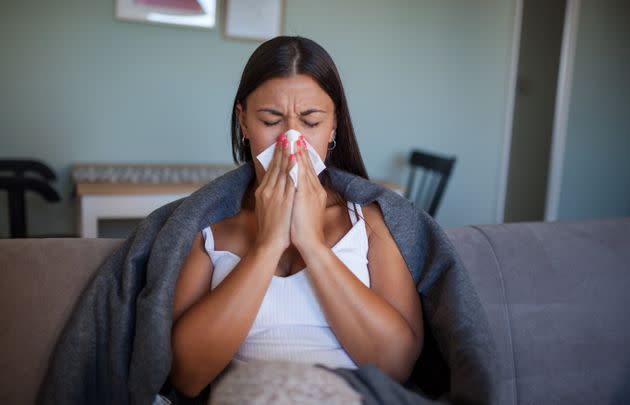Experts Predict If And When COVID Will Become A Seasonal Illness
The vast majority of respiratory viruses that spread within our population ebb and flow with the seasons.
Influenza spikes in the winter months, as do infections caused by respiratory syncytial virus (RSV), adenoviruses and other coronaviruses. Earlier this year, Rochelle Walensky, the Centers for Disease Control and Prevention director, said she expects COVID to also become a seasonal illness — but whether or not that will come to be remains to be seen.
Most scientists agree that COVID isn’t going anywhere, and that we’ll be living with SARS-CoV-2 for decades, if not forever. Though we tend to see the biggest waves in the winter and early spring, COVID isn’t seasonal yet. It doesn’t retreat in the spring-to-summer off-season — it is smoldering throughout the year.
“COVID is steadily burning through the population as we speak. But it is also able to piggy back on top of our ebbs and flows of the typical cold and flu season, so it’s a double whammy,” Mark Cameron, an infectious disease researcher at Case Western Reserve, told HuffPost.
Will COVID ever become a seasonal illness?
Andrew Noymer, an epidemiologist and demographer who studies infectious diseases at University of California, Irvine, expects COVID to become winter-dominant, like the flu, in the long run. SARS-CoV-2 is already somewhat seasonal and predictable in nature.
“In the United States, all of the largest spikes have been in the winter, so it is kind of seasonal in that respect,” Noymer said.
But, even between those peaks, the virus spreads at pretty significant levels. It hasn’t totally settled into a seasonality. Many epidemiologists thought COVID would have already fallen into much more of a seasonal pattern by now — but it hasn’t.
“A seasonal infectious disease is something that pops up predictably at the start of the cold and flu season and persists throughout that period of time,” Cameron said.
Keep in mind, this is only our third 12-month period with COVID. The illness is still relatively new. Even though over half of the U.S. population has likely already had COVID, many have not and remain susceptible. We’re all antsy for the virus to become predictable, but the virus is still just getting started, Noymer said. He suspects that one day — maybe 10, 15 years from now — we’ll be looking at a very seasonal phenomenon.

There's a chance COVID may not become seasonal for years to come. (Photo: Marija Babic / EyeEm via Getty Images)
Is there a chance COVID may never sync up with the flu and cold season and become a winter-dominant illness? Of course, Noymer said. “I can’t absolutely rule out that it never will — that it will be the one exception that disproves the rule.”
The fact that, one, people can get COVID multiple times, and two, that even vaccinated people can catch and spread COVID, makes the epidemiology of this respiratory infection chaotic. Population-level immunity influences when waves occur. After people recover from COVID, they are typically protected from infection for a few months. As time passes, those recently recovered people can become susceptible again. And, on a greater scale, a population can become susceptible to a wave again.
This isn’t an exact science — people get infected and recover at different times. Their immunity wanes at different speeds. “There’s a lot of wheels turning and it’s very hard to predict,” Noymer said.
Here’s what causes respiratory viruses to become seasonal.
It’s not entirely clear why respiratory viruses tend to get more active in the wintertime — but they do. Flu activity surges in the winter as do the common cold coronaviruses. Even measles was winter-dominant when it circulated at higher levels in the U.S., according to Noymer.
“We see this with respiratory virus after respiratory virus after respiratory virus,” Noymer said.
There are a few hypotheses as to why this happens. The first theory is atmospheric conditions — viruses, including influenza, tend to spread more easily when there’s less humidity. Viruses do better in drier conditions.
Another contributing factor is our behavior. In winter months, when it’s cold outside, we gather indoors together and create plenty of opportunities for viruses to spread from person to person. This is also believed to be why the South experiences summer spikes. Contrary to those in the northeast, people living in the South head indoors during the summer months when the temperature soars and humidity becomes wet and sticky. Schools are thought to contribute to the seasonal spread of respiratory viruses like flu and RSV, Noymer added.
The behavior of the virus plays a role, too. The flu, for example, tends to shoot through the population then burn itself out by “mutating to its demise,” Cameron said. COVID, on the other hand, is evolving to become more fit and more transmissible — it’s not acting like a typical respiratory virus that infects people and goes away before bursting back into the population in a different form months later.
If we look to other circulating coronaviruses that cause the common cold, we can reasonably expect COVID to eventually become endemic and more seasonal in nature, according to Cameron. But we don’t know when those coronaviruses settled in their seasonality. How long that will take with COVID is a mystery. This is wide-open territory that has yet to be studied.
“How can we understand how long COVID will take to become just another garden-variety coronavirus that is circulating and causing sporadic disease?” Cameron said. “It certainly isn’t now.”
Experts are still learning about COVID-19. The information in this story is what was known or available as of publication, but guidance can change as scientists discover more about the virus. Please check the Centers for Disease Control and Prevention for the most updated recommendations.
This article originally appeared on HuffPost and has been updated.

